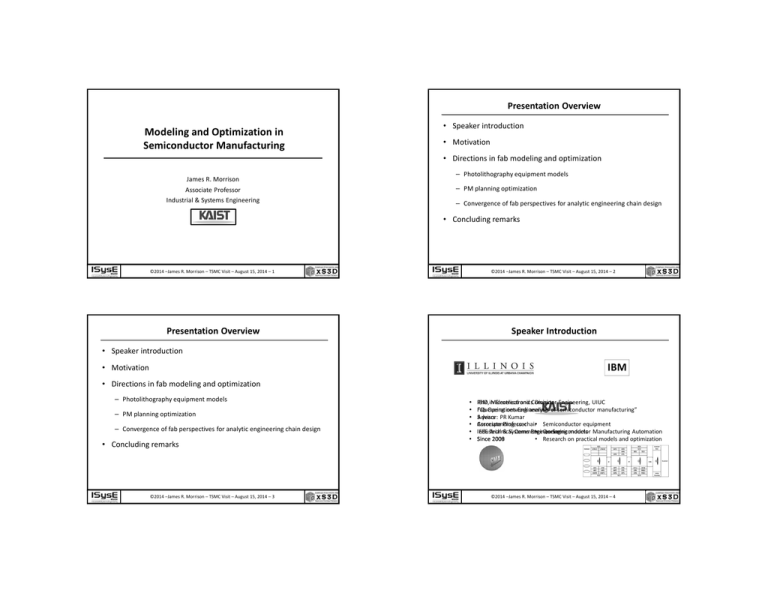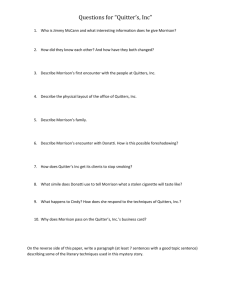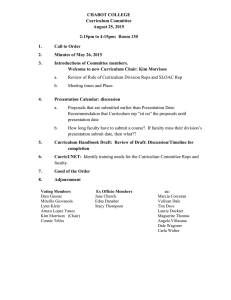Modeling and Optimization in Semiconductor
advertisement

Presentation Overview
Modeling and Optimization in
Semiconductor Manufacturing
• Speaker introduction
• Motivation
• Directions in fab modeling and optimization
James R. Morrison
Associate Professor
Industrial & Systems Engineering
– Photolithography equipment models
– PM planning optimization
– Convergence of fab perspectives for analytic engineering chain design
• Concluding remarks
©2014 –James R. Morrison – TSMC Visit – August 15, 2014 – 1
©2014 –James R. Morrison – TSMC Visit – August 15, 2014 – 2
Presentation Overview
Speaker Introduction
• Speaker introduction
IBM
• Motivation
• Directions in fab modeling and optimization
– Photolithography equipment models
– PM planning optimization
– Convergence of fab perspectives for analytic engineering chain design
• Concluding remarks
©2014 –James R. Morrison – TSMC Visit – August 15, 2014 – 3
•
•
•
•
•
•
IBM,
PhD in
Microelectronics
Electrical and Computer
Division Engineering, UIUC
Fab
“Queueing
Operations
network
Engineering
analysis of semiconductor manufacturing”
5Advisor:
years PR Kumar
Associate Professor
Corresponding
co-chair• Semiconductor equipment
• Queueing
models Manufacturing Automation
Industrial
IEEE
Technical
& Systems
Committee
Engineering
on Semiconductor
Since 2009
2008
• Research on practical models and optimization
©2014 –James R. Morrison – TSMC Visit – August 15, 2014 – 4
Presentation Overview
Motivation (1)
• Speaker introduction
• Semiconductor manufacturing
– Global revenue in 2013: NT$ 9,540 billion (US$ 318 billion)
• Motivation
[1]
• Directions in fab modeling and optimization
• Construction costs
– 300 mm wafer fab:
– 450 mm wafer fab:
– Photolithography equipment models
NT$150 billion
NT$300-450 billion
(US$ 5 billion [2])
(US$10-15 billion)
– PM planning optimization
– Convergence of fab perspectives for analytic engineering chain design
– 1996-1999: Fab production control method earned Samsung NT$ 15
billion (US$ 1 billion [3]) additional revenue
– 2005: IBM’s 30 independent supply chains merged into a single global
system and saved NT$ 180 billion (US$ 6 billion [4])
– …
• Concluding remarks
©2014 –James R. Morrison – TSMC Visit – August 15, 2014 – 5
©2014 –James R. Morrison – TSMC Visit – August 15, 2014 – 6
Motivation (2)
Presentation Overview
• Clustered photolithography tools (CPT)
–
–
–
–
• Significant value for improvements
• Speaker introduction
Purchase cost of NT$ 0.6-3 billion (US$ 20-100 M [5])
The most expensive tool in a fabricator
Typically the bottleneck of the fabricator
Key yield and cycle time contributor
• Motivation
• Directions in fab modeling and optimization
– Photolithography equipment models
– PM planning optimization
– Convergence of fab perspectives for analytic engineering chain design
• Concluding remarks
[5]
©2014 –James R. Morrison – TSMC Visit – August 15, 2014 – 7
©2014 –James R. Morrison – TSMC Visit – August 15, 2014 – 8
System Description: CPT (1)
System Description: CPT (2)
[6]
Conceptual diagram of a CPT (slightly simplified)
Scanner
Pre-scan processes
Clustered
Photolithography
Tool
P2
P1
Wafers
Enter
P2
P1
P3
Scanner
P6
P5
P4
P2
Wafer handling robots
P11
Wafers
Exit
Multi-cluster tool, robot in each cluster, IF buffers, STK buffer
Scanner is often the CPT bottleneck
Largely deterministic process times
Process time can vary by product
Setups between lots (reticle changes, pre-scan setup, …)
Wafer handling robot decision policy & deadlock prevention
P11
P8
P9
P10
P8
P9
P11
P7
P8
Post-scan processes
Conceptual diagram of a CPT (robots “removed”)
Wafers
Enter
Pre-scan
processes
buffer
buffer
P2
buffer
buffer
buffer
buffer
Post-scan
processes
…
•
•
•
•
•
•
Buffer
P4
P1
P2
P1
…
P2
Scanner
P6
P11
…
P11
P11
©2014 –James R. Morrison – TSMC Visit – August 15, 2014 – 9
©2014 –James R. Morrison – TSMC Visit – August 15, 2014 – 10
System Description: Performance Metrics
Models for CPTs
Notation
– Al: arrival time of lot l to the tool queue
– Sl : start time of lot l on a tool
– Cl : completion time of lot l on a tool
– Wl : wafers in lot l
• Performance measures
Computation time
– Cycle time of lot l:
TlCT := Cl - Al
– Process time of lot l:
TlPT := Cl - Sl
– Throughput time of lot l: TlTT := min{ TlPT, Cl – Cl-1 }
•
T1TT
•
Wafers
Exit
Models with various levels of detail
Detailed Model
Linear Model
“Everything”
A(k1)
A(k1), B
Affine Models
A(k1), B(k1)
A(k1), B(k1, k2)
Flow Line
Models
Parametric flow lines
Empirical flow lines
Collect
Tool Log Data
Train a set of
parameters
T2TT
T3TT
Lot 1
With complete tool log data
Lot 2
Lot 3
Time
©2014 –James R. Morrison – TSMC Visit – August 15, 2014 – 11
Exit Recursion
Models
With wafer in/out log data
Simulate
models
With lot in/out log data
©2014 –James R. Morrison – TSMC Visit – August 15, 2014 – 12
Computational Comparison
Linear Model
Affine Model
ER Model
Accuracy Assessment
Model
Computation Time
Linear Model
0.44
Affine Model-B
2.01
Linear Model
CT
LRT
TT
CT
LRT
TT
CT
LRT
TT
Affine Model-B(k)
2.35
Affine Models
CT
LRT
TT
CT
LRT
TT
CT
LRT
TT
Affine Model-B(k1,k2)
1.57
ER Models
CT
LRT
TT
CT
LRT
TT
CT
LRT
TT
ER Model - Tool Log
0.88
Flow Line Models
CT
LRT
TT
CT
LRT
TT
CT
LRT
TT
ER Model - Wafer Log
0.73
ER Model - Lot Log
0.36
Flow Line Model
134.38
Empirical FL Model
64.66
Detailed Simulation
11404.98
FL Model
DS
Same Sample, Same Parameter Different Sample, Same Parameter Different Sample, Different Parameter
• Errors relative to detailed model
– Error of 20%+
– Error 5-20%
– Error 0-5%
©2014 –James R. Morrison – TSMC Visit – August 15, 2014 – 13
©2014 –James R. Morrison – TSMC Visit – August 15, 2014 – 14
Application Opportunities: Capacity Optimization
Application Opportunities: Toolset Agility (1)
• Fundamental process/robot bottleneck analysis & mitigation
buffer
buffer
Pre-scan
processes
Post-scan
processes
…
Wafers
Enter
P1
P1
P2
P2
…
P2
buffer
buffer
buffer
buffer
Scanner
P6
P11
…
• More complicated analysis
– Buffer size implications
– Manufacturing environment & mitigation
– Penultimate dominating process
©2014 –James R. Morrison – TSMC Visit – August 15, 2014 – 15
Wafers
Exit
• Wafers are commonly admitted to a CPT as soon as possible
– Deployment opportunity of the lot is reduced
– High priority hot lots experience additional queueing
– Lot/wafer residency time and buffer level greater than required
P11
P11
• Question: When should wafers be admitted to the CPT?
– Maintain throughput capacity
– Minimize residency time and thereby increase agility
©2014 –James R. Morrison – TSMC Visit – August 15, 2014 – 16
Application Opportunities: Toolset Agility (2)
Application Opportunities: Toolset Agility (3)
• Results: Detailed CPT model
JIT
Trade-off between
throughput and wafer
residency time
Lexicographic Multi-Objective
Linear Program (LMOLP) ([14])
©2014 –James R. Morrison – TSMC Visit – August 15, 2014 – 17
©2014 –James R. Morrison – TSMC Visit – August 15, 2014 – 18
Application Opportunities: Fab Simulation/Optimization
Presentation Overview
• Equipment and fabricator simulations are used to
– Predict value of changes to fabricator capacity
– Predict value of changes to fabricator production control policies
– Predict capacity of fabricators
• Want expressive, accurate and computationally tractable
models to help make decisions on US$ billions
– Future manufacturing facilities will cost US$15 billion
– High quality models enable improved decisions
• Speaker introduction
• Motivation
• Directions in fab modeling and optimization
– Photolithography equipment models
– PM planning optimization
– Convergence of fab perspectives for analytic engineering chain design
• Concluding remarks
• Can also be used for model based optimization
– Production control
©2014 –James R. Morrison – TSMC Visit – August 15, 2014 – 19
©2014 –James R. Morrison – TSMC Visit – August 15, 2014 – 20
Brief Overview: Preventive Maintenance
PM Decision Tiers
• “The care and servicing of equipment… including tests,
measurements, adjustments and parts replacement,
performed specifically to prevent faults from occurring” –
Wikipedia.org
• Planned PM activities
– Increase planned downtime
– Overall equipment availability
– Equipment reliability
– Unplanned tool failures
• FOCUS: Tier 1 with a roughly yearly perspective
• QUESTION: How frequently to conduct PMs?
“PM
planning”
PMs are essential for manufacturing performance… need careful consideration
©2014 –James R. Morrison – TSMC Visit – August 15, 2014 – 21
©2014 –James R. Morrison – TSMC Visit – August 15, 2014 – 22
Fundamental Tradeoffs: Frequency of Setups (1)
Fundamental Tradeoffs: Frequency of Setups (2)
• Consider a major PM in a cluster tool
– Service activities
• 30 primary components to service
• 2 hours/component on average
• Each must be conducted once every month
One month cycle: 30 separate PMs (1 component each)
Setup: 6 hrs
Tool uptime: 16 hrs
1 component PM: 2 hrs
One month cycle: 1 PM (All 30 components at once)
– Setup activities
• Cool down, vent, pump, conditioning, qualification
• Duration about 6 hours total each time
• How many components should we service in each PM?
– How many setups do we have per month?
– What is the resulting tool availability?
©2014 –James R. Morrison – TSMC Visit – August 15, 2014 – 23
Tool availability = 66.7%
…
Setup: 6 hrs
Tool uptime: 654 hrs
Tool availability = 90.8%
30 component PM: 60 hrs
• Tradeoffs
– Fewer setups Increased availability
– Fewer setups Large WIP bubbles
• Goal: Determine how often we plan to take tool down for PM
©2014 –James R. Morrison – TSMC Visit – August 15, 2014 – 24
System Description: G/G/m-Queue
PM Plan Optimization (1)
Servers
Waiting room
Customers
arrive
Served
customers
exit
⋮
•
Nonlinear programming problem
•
There are n types of PM.
Min !" , … , !$ <//-queue with tool failure>
•
•
•
•
•
•
•
The number of servers , customer interarrival times are generally distributed with rate The service time of a customer has general distribution with rate Generally distributed failure intervals with mean Time-based preemptive events
Exponentially distributed available intervals of mean The mean availability of the server A
The coefficient of variation of the downtimes ,the coefficient of variation of the service times The effective coefficient of variation of the service time ,
,
≔
∑*+,
-
&'(
.
)(
∑*+,
/0(
1(
(system loading constraint)
2+ 3 !( 3 4+ 5 6 1,2, … , 7
,
2
1
1 1 Subject to
(System loading constraint means 1 for stability)
1 1 ©2014 –James R. Morrison – TSMC Visit – August 15, 2014 – 25
©2014 –James R. Morrison – TSMC Visit – August 15, 2014 – 26
PM Plan Optimization (2)
Numerical Results
∏*+, !( •
Parameters in the NLP8) 6
•
:+ : The number of PM occurrence of the type 58<in =0, 8) ?.
•
@* : When there are n types of 8<A,the total number of PM occurrence in =0, 8) ?.
•
B+ :The PM occurrence probability of the type 58< in =0, 8) ?.
•
C( : The mean down time of the type 58<.
(
• Examples inspired by fab data
(
(
Parameters
(
Total duration (hrs)
DE)
(
DE)
, @* 6 ∑*+,
(
C( 6
•
:+ 6
•
!" , … , !$ 6 ∑*+, B+ C( 6 JK LM
)(
, B+ 6
F(
,
G$
)(
DE) ∑$
(O"F( N( (
•
!" … , !$ 6
•
!" , … , !$ 6
•
A !" , … , !$ 6 G$
PQR=?
S T
Y
Y S
6
6
T ST
S T
DE)
G$
6
H(
)(
1(
DI(
66
14.8349
3
3
, !" , … , !$ 6
ST
J K VM
T
S
6 1 VM 6 W+ Original Plan
Type 2
Type 1
Type 2
Total duration (hrs)
240
720
52.5677
403.4836
PM duration (hrs)
66
30
14.4561
16.8118
Setup time (hrs)
3
4
3
4
0.6694
System loading
0.7632
0.8123
Cycle time (hrs)
40.4364
22.9174
0.6653
0.6164
System loading
0.7046
0.7605
Cycle time (hrs)
35.7362
21.1243
Z
[
©2014 –James R. Morrison – TSMC Visit – August 15, 2014 – 27
Optimal Plan
Type 1
53.9452
Setup time (hrs)
0.7125
Parameters
Availability
T
T
∑$
(O" U( =C( ?S
240
Optimal Plan
PM duration (hrs)
Availability
(
Multiple PM Types
Single PM Type
Original Plan
©2014 –James R. Morrison – TSMC Visit – August 15, 2014 – 28
Presentation Overview
• Speaker introduction
• Motivation
• Directions in fab modeling and optimization
Motivation for Analytic Engineering Chain Management
• Supply Chain Management (SCM)
– 2005: IBM’s 30 independent supply chains merged into a single global
system and saved NT$ 180 billion (US$ 6 billion [4])
– Competitive advantage for Infineon
– Required for success in many industries
– Photolithography equipment models
– PM planning optimization
– Convergence of fab perspectives for analytic engineering chain design
• Concluding remarks
• Engineering Chain Management
– Engineering chain consists of all activities from design of the product
to design of the manufacturing system
• Opportunities
– Largely addressed by business philosophy or project management
– Each component shares limited information with other components
©2014 –James R. Morrison – TSMC Visit – August 15, 2014 – 29
©2014 –James R. Morrison – TSMC Visit – August 15, 2014 – 30
Concept for AECM
Presentation Overview
• Speaker introduction
• Motivation
• Directions in fab modeling and optimization
– Photolithography equipment models
– PM planning optimization
– Convergence of fab perspectives for analytic engineering chain design
• Concluding remarks
©2014 –James R. Morrison – TSMC Visit – August 15, 2014 – 31
©2014 –James R. Morrison – TSMC Visit – August 15, 2014 – 32
Concluding Remarks
• Directions in fab modeling and optimization
– Photolithography equipment models
– PM planning optimization
Modeling and Optimization in
Semiconductor Manufacturing
– Convergence of fab perspectives for analytic engineering chain design
• Application opportunities
– CPT capacity optimization, CPT toolset agility
Questions and Discussion
– Fab simulation/optimization
– Combined perspectives for next generation optimization
James R. Morrison
Associate Professor
• Future directions
Industrial & Systems Engineering
– Industry engagement
– Further model development
©2014 –James R. Morrison – TSMC Visit – August 15, 2014 – 33
References
1.
2.
3.
4.
5.
6.
7.
8.
9.
10.
11.
12.
13.
14.
HIS iSuppli April 2011
Elpida Memory, Inc., available at http://www.eplida.com,
Leachman, Robert C., Jeenyoung Kang, and Vincent Lin. "SLIM: Short cycle time and low inventory in manufacturing at samsung
electronics." Interfaces32.1 (2002): 61-77
http://www.forbes.com/forbes/2003/0811/076.html
Roger H. French and V. Hoang, “Immersion Lithography: Photomask and Wafer-Level Materials,” Tran. Annual Review of Materials Research, Vol.
39, 93-126
Hyun Joong Yoon and Doo Yong Lee, “Deadlock-free scheduling of photolithography equipment in semiconductor fabrication,” IEEE Trans. Semi.
Mfg., vol. 17, no. 1, pp. 42-54, 2004
Avi-Itzhak, B. "A sequence of service stations with arbitrary input and regular service times." Management Science 11.5 (1965): 565-571
Friedman, Henry D. "Reduction methods for tandem queuing systems." Operations Research 13.1 (1965): 121-131
Park, Kyungsu, and James R. Morrison. "Performance evaluation of deterministic flow lines: Redundant modules and application to semiconductor
manufacturing equipment." Automation Science and Engineering (CASE), 2010 IEEE Conference on. IEEE, 2010
Morrison, James R. "Deterministic flow lines with applications." Automation Science and Engineering, IEEE Transactions on 7.2 (2010): 228-239
Morrison, James R. "Multiclass flow line models of semiconductor manufacturing equipment for fab-level simulation." Automation Science and
Engineering, IEEE Transactions on 8.1 (2011): 81-94
Kim, Woo-sung, and James R. Morrison, “On the steady state behavior of deterministic flow lines with random arrivals.” Accepted June 14, 2014
for IEEE Transactions on Automation Science and Engineering (IEEE)
Kim, Woo-sung and James R. Morrison, “The throughput rate of serial production lines with regular process times and random setups: Markovian
models and applications to semiconductor manufacturing,” Computers & Operations Research (Elsevier), Online at
http://dx.doi.org/10.1016/j.cor.2014.03.022, April 4, 2014.
Park, Kyungsu and James R. Morrison, “Controlled wafer release in clustered photolithography tools: Flexible flow line job release scheduling and
an LMOLP heuristic,” IEEE Transactions on Automation Science and Engineering (IEEE), Online at http://dx.doi.org/10.1109/TASE.2014.2311997,
April 7, 2014.
Longest waiting pair: [7] Geismar, H.N.; Sriskandarajah, C.; Ramanan, N., "Increasing throughput for robotic cells with parallel Machines and multiple
robots," IEEE Trans. Auto. Sci. and Eng., vol.1, no.1, pp.84,89, Jul 2004
©2014 –James R. Morrison – TSMC Visit – August 15, 2014 – 35
©2014 –James R. Morrison – TSMC Visit – August 15, 2014 – 34


